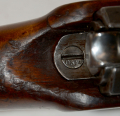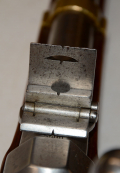site search
online catalog
HISTORY CHANGING PRUSSIAN DREYSE NEEDLE FIRE RIFLE

$3,495.00
Originally $3,975.00
Quantity Available: 1
Item Code: 88-221
Shipping: Determined by Method & Location of buyer
To Order:
Call 717-334-0347,
Fax 717-334-5016, or E-mail
In 1836 Johann Nikolaus Dreyse revolutionized the world of military firearms by submitting his bolt action “needle rifle” to the Prussian military for testing and trials. Dreyse was certainly on the cutting edge of the firearms business at the time, as the percussion cap was still nearly two decades from somewhat universal, worldwide acceptance. It was at this time that Dreyse started to experiment with self-contained paper cartridges. Dreyse developed a paper cartridge that contained not only the bullet and the powder, but also the percussion cap, which was situated at the bottom of the bullet, forward of the powder charge. Placing the cap in that location allowed the base of the bullet to act as the anvil upon which the cap could be detonated when it was struck. Dreyse also developed a long, needle-like pin that was tensioned by a coil spring and was effectively the first widely produced firing pin design.
In 1841 the new infantry rifle was designated the “Light Percussion Rifle M1841” was meant to conceal the revolutionary nature of the new firearm, but by 1855 the term "Needle Gun" was in general use within the Prussian military. The rifle was a 15.4mm (about .61 caliber), single shot, bolt-action breechloader that looked rather like the previous generations of Prussian muzzleloading flintlock and percussion muskets. The M1862 we are offering retained the 15.4mm caliber, broad 4-groove rifling and the needle fire bolt-action system but was produced with improved tolerances in an attempt to limit leakage and improve interchangeability. The new rifle also had a slightly shorter, 32 ½” barrel and the “short butt variant” was only 52 ¾” in overall length. The Prussians used the Zündnadelgewehr with devastating effectiveness against the Austrian infantry during the Austro-Prussian War of 1866, where observers commented on the fact that a prone Prussian infantryman could fire 5 rounds in the time it took a standing Austrian infantryman to load his rifle one time. During the Franco-Prussian War the weapon dealt devastating fire but was outperformed by the French Model 1866 Chassepot.
Offered here is a great example of a Model 1862 Needle Rifle. The rifle remains in very fine overall condition and is all complete with all matching serial numbers including the bolt and the "needle" is intact. The rifle was manufactured at the Prussian national arsenal at Danzig. On the left flat, below the arsenal mark is the mode "B.G. MOD 62" in Germanic script. The upper angled receiver flat on the right side is marked with the year of manufacture "1868". The rifle is serial number "7090", and the full serial number is present on the left forward portion of the receiver and on the left reward portion of the barrel where it meets the receiver. The brass furniture bears Prussian inspection marks. The top of the iron butt plate is unit stamped: "21 R. 11.107. Which translates to the 21st Regiment. 11th Company. 107th man. The 21st Regiment aka the 4th Pomeranian regiment was engaged in several battles against the French 1870-71.
Prussian inspection and proof marks are clearly stamped on the right side of the receiver and barrel. Numerous inspection marks are present in the stock as well. The metal of the rifle remains almost entirely smooth, with only some very lightly scattered minor pinpricking here and there along the length of the barrel and around the receiver. Some more moderate pinpricking is present around the hexagonal chamber of the receiver, at the muzzle and on the butt plate which also shows a moderately oxidized brown patina. The bore of the rifle is in fine condition with crisp four-groove rifling. There is only some lightly scattered oxidation and discoloration along the length of bore, along with some minor light pitting and some frosting in the grooves. The bolt action mechanism functions correctly, as does the cocking mechanism. The full long needle is intact. The rifle retains its original rear sight with the fixed block, small folding leaf, and long range adjustable folding leaf. The original cleaning rod is present. Both original sling swivels are in place. The stock of the rifle is in fine overall condition. There is a hair-line crack on the left side of the receiver on the stock, but it does not affect the soundness of the gun and could be easily glued. Some surface scuffs are present on the wood as well, but the edge remain strong and relatively sharps. As would be expected, the stock shows the usual assortment of scattered bumps, dings, scuffs, and surface mars that any combat carried rifle would have.
Overall, the rifle remains in extremely fine condition and is a wonderful example of the type of arms carried by front-line Germanic states infantryman during the Franco-Prussian War. The rifle is nicely unit marked on the butt to a unit that served with great distinction prior to and during the Franco-Prussian War. [pe][ph:L]
DISCLAIMER: All firearms are sold as collector's items only - we do not accept responsibility as to the shooting safety or reliability of any antique firearm. All firearms are described as accurately as possible, given the restraints of a catalog listing length. We want satisfied customers & often "under" describe the weapons. Any city or state regulations regarding owning antique firearms are the responsibility of the purchaser. All firearms are "mechanically perfect" unless noted, but again, are NOT warranted as safe to fire.
~~~~~~~~~~~~~~~~~~~~~~~~~~~~~~~~~~~
THIS ITEM, AS WITH ALL OTHER ITEMS AVAILABLE ON OUR WEB SITE,
MAY BE PURCHASED THROUGH OUR LAYAWAY PROGRAM.
CLICK HERE FOR OUR POLICIES AND TERMS.
THANK YOU!
Inquire About HISTORY CHANGING PRUSSIAN DREYSE NEEDLE FIRE RIFLE
For inquiries, please email us at [email protected]
Most Popular
Historical Firearms Stolen From The National Civil War Museum In Harrisburg, Pa »
Theft From Gravesite Of Gen. John Reynolds »
Selection Of Unframed Prints By Don Troiani »
Fine Condition Brass Infantry Bugle Insignia »
British Imported, Confederate Used Bayonet »
Piece Of Wood From The Room In The White House Where Lincoln Signed The Emancipation Proclamation »
featured item
VERY RARE CONFEDERATE “ROPE BORDER” BELT PLATE
Dug condition stamped brass oval “rope border” belt plate. Unlike their US counterparts, these were not lead filled. These are not commonly found and can most often be traced back to the contractor Magee and George of New Orleans. The firm of… (1202-260). Learn More »
site search
Upcoming Events
The shop will remain closed to the public through Friday, Jan. 31st, re-opening on Saturday, Feb.… Learn More »






















